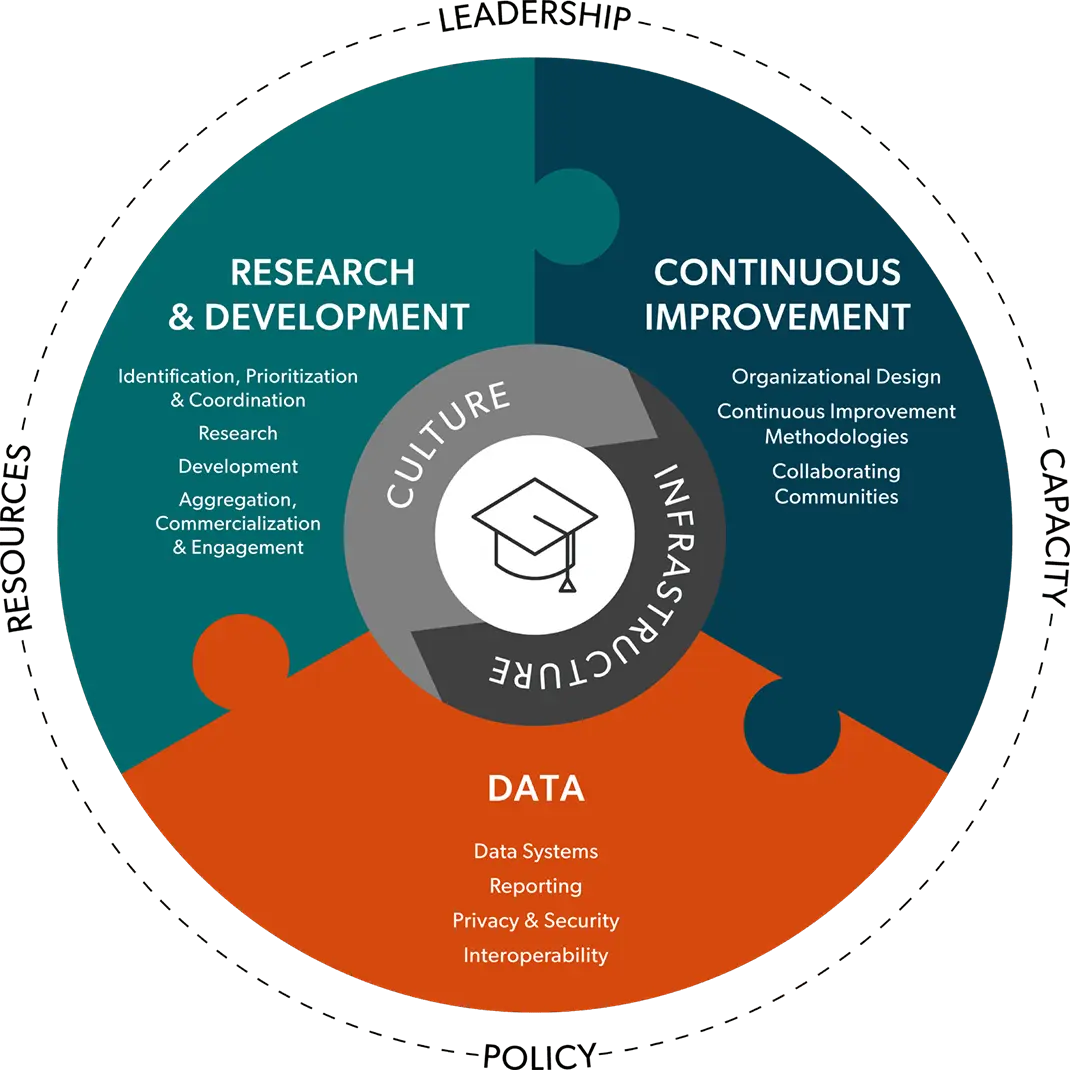Learning systems approaches can look different across all levels of the education system. But at their heart, these approaches help everyone make better decisions and solve complex challenges.

Consider these examples:
A fourth-grade teacher adjusts the next day’s lesson plan based on his students’ exit ticket answers. He relies in part on a What Works Clearinghouse practice guide, a federal synthesis of evidence-based approaches, to correct a common misunderstanding about comparing fractions within his class.
A middle school principal leads her leadership team through a mid-year data cycle, with a focus on examining progress among specific groups of students. They rely on a data dashboard that pulls together information on each student from all parts of the school, from academics to attendance to behavior to out-of-school time supports. The team makes adjustments to their current approaches, including incorporating some evidence-based techniques their district suggested during a recent school walkthrough. They conclude the meeting by planning how to track progress and when to reconvene to consider further changes.
A school district operations team analyzes data to design more efficient bus routes, which increases students’ on-time attendance.
The state department of education co-develops a learning agenda — an evidence-building plan that systematically identifies and seeks to answer priority short- and long-term questions—with a diverse set of stakeholders and then partners with a local university to implement it. They design both impact and implementation studies that match the authentic questions being asked by practitioners and community members.
During a monitoring cycle, a Title II program officer at the U.S. Department of Education confirms critical compliance matters and then focuses her questions to grantees on inviting them to share what data/evidence they have built, what they have learned and what they will do differently in the future to improve.
A community-based organization partners with a company that is developing a game-based math program that aligns with the organization’s after school tutoring program. Together, they pilot and iterate on the program, including making changes based on student feedback.
A philanthropy funds a fellowship through which PhD students at a nearby university conduct collaborative, applied research in partnership with the local school district.
After auditing their curriculum against the current evidence base including data on the placement and tenure of its graduates, a teacher preparation program revises aspects of its pedagogical coursework to align with the science of learning and development. The program also launches a new course in navigating the evidence base and data-informed decision making.
The Learning Systems Framework
Learning systems are dynamic and responsive to the needs of everyone within them. Like in other industries such as health and technology, learning systems run on culture and infrastructure.
First, within a learning system is a culture that inspires people to use a wide variety of information to continuously learn and improve.
Second, learning systems rely on infrastructure that provides the critical backbone which helps reinforce and accelerate improvement.
The three components of a learning system infrastructure are Research & Development, Continuous Improvement, and Data. When all three are in place and working together, this infrastructure is like a smooth and well-maintained road that allows us to move from the status quo to a better place. Also within a learning system are four key drivers that keep it moving: people with the necessary capacity, sufficient resources, strong leadership, and enabling policies and incentives.

Research & Development Infrastructure
A robust R&D infrastructure supports the generation and evaluation of research, evidence, tools, programs, policies, and practices to bolster student outcomes.
Continuous Improvement Infrastructure
A continuous improvement infrastructure helps teams in education keep getting better by working together on policies and practices, using different types of information to make smart decisions, adapting ideas to fit different situations, and growing successful methods to help more people learn effectively.
Data Infrastructure
An effective data infrastructure provides stakeholders in education with timely, tailored information to support informed decision-making while protecting privacy.
Research & Development Infrastructure: A robust R&D infrastructure supports the generation and evaluation of research, evidence, tools, programs, policies, and practices to bolster student outcomes.
Data Infrastructure: An effective data infrastructure provides stakeholders in education with timely, tailored information to support informed decision-making while protecting privacy.
Continuous Improvement Infrastructure: A continuous improvement infrastructure helps teams in education keep getting better by working together on policies and practices, using different types of information to make smart decisions, adapting ideas to fit different situations, and growing successful methods to help more people learn effectively.
What do you mean by...?
The “Learning” in Learning System
An education system oriented toward learning is a living, responsive system that makes regular use of data, research, innovation, judgment, input, and feedback to continuously improve how we address opportunity gaps and boost outcomes for every student.
The “System” in Learning System
Infrastructure and culture work together in a well-functioning system. In this context, a system encompasses all levels and corners of our education system, including every contributor to the shared project of educating the public. This includes classroom teachers and federal decision makers, after school tutors and education researchers, district data analysts and community leaders, and of course students and families.
Culture
It’s the habitual patterns of how people within the education system think, behave, and adapt. Our vision for an ideal organizational culture supporting a learning system approach is educators and policymakers feeling empowered and supported in building and using a wide variety of evidence to learn and improve in all aspects of their work.
Infrastructure
It’s the foundational resources, structures, and processes that work together to help ensure the whole system functions and gets stronger over time. The three distinct components of a learning system infrastructure are Research & Development, Data, and Continuous Improvement.
Learn more about the LSLN’s vision for a robust learning system in education:
LSLN Publications
Transforming the Education Sector into a Learning System (2019)
Transforming Education into a Learning System: Reflections on the Pandemic (2021)
The Learning Systems Leadership Network (LSLN) brings together rich expertise and experience across the education space. We’re transforming our education system into a learning system, unlocking its full ability to advance the incredible potential of each and every student and practitioner and help policies and practices become more effective. LSLN collectively advocates for shifts, both big and small, that pave the way for an education system that’s intentionally designed to lead to student success. We’re starting by elevating the need for learning system approaches as a top priority, because it enables all other changes, especially the transformation we need to deliver the education our students deserve.
Learning Systems Leadership Network members come from all corners of the education ecosystem. We are committed to creating urgency around transforming public education into a true learning system, and we are acting both individually and collectively to strengthen the culture and infrastructures to support this shift.
Members include leaders from the following organizations and these individuals:
* LSLN membership does not imply full endorsement of all network actions.
